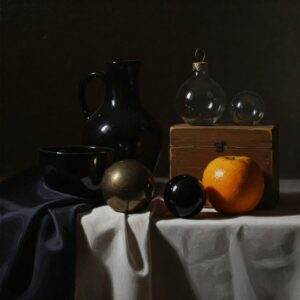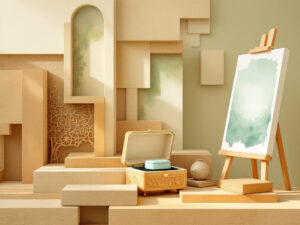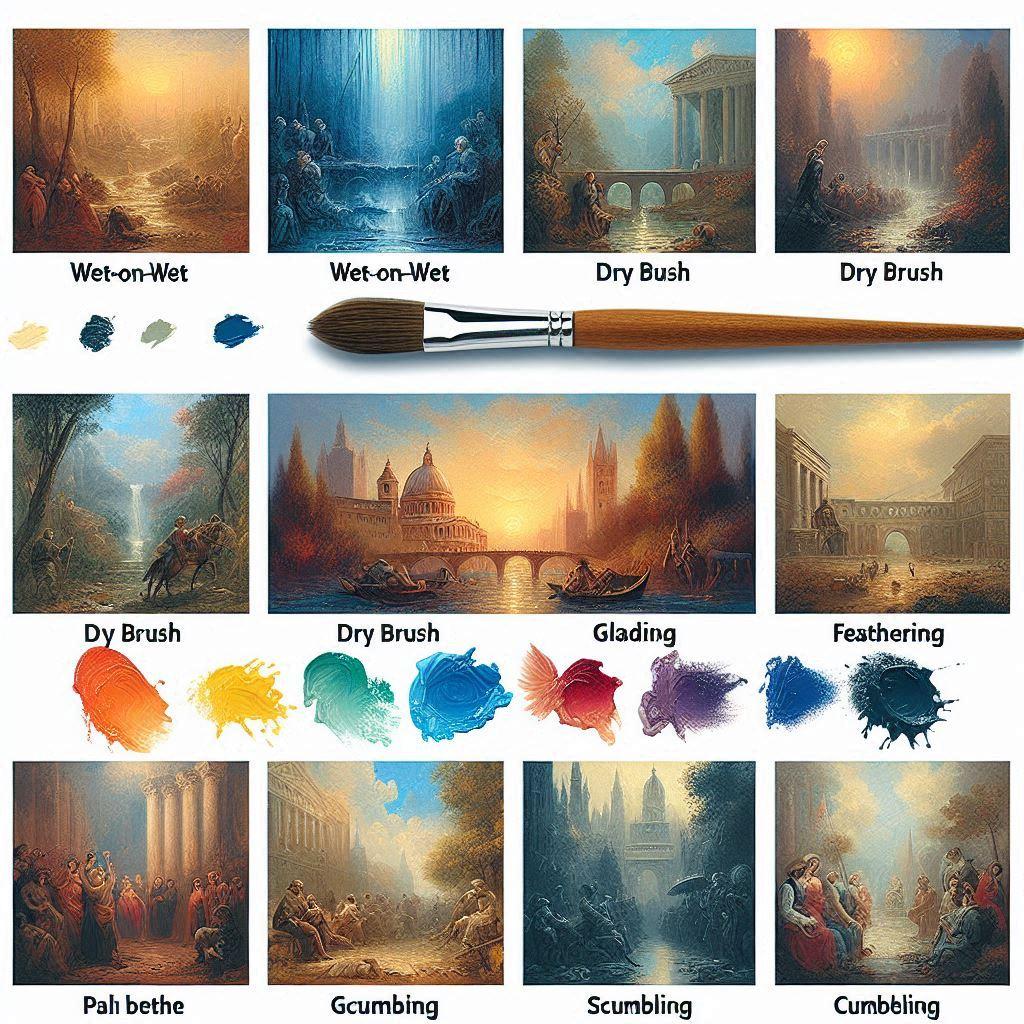When you look at a great painting, it often feels like you could step right into it. That’s because skilled artists know how to create depth in paintings that trick our eyes into seeing a three-dimensional world on a flat canvas. Learning to add depth to your artwork transforms simple paintings into captivating scenes that draw viewers in and hold their attention. Whether you’re painting landscapes, still lifes, or portraits, these proven techniques will help you achieve realistic results that make your art come alive.
Key Points:
- Value (light and dark) is the foundation for creating depth in art
- Color temperature and saturation guide the viewer’s eye through the painting
- Perspective techniques provide structure to your spatial composition
- Strategic placement of details enhances the illusion of distance
- The integration of multiple techniques creates the most convincing results
Understanding Depth in Art
Creating depth in paintings isn’t just about making things look real—it’s about building a visual journey that guides viewers through your artistic world. On a flat canvas, depth refers to the illusion of space between the foreground (closest to the viewer), midground, and background (farthest from the viewer). Our brains naturally interpret lower areas of a composition as being closer and higher areas as farther away.
To create convincing depth, artists combine multiple techniques that work together to establish spatial relationships between elements. When these techniques are properly integrated, a painting becomes a window into another world rather than just a decorated surface.
Why Depth Matters in Painting
Adding depth to your artwork accomplishes several important goals:
- Creates more dynamic, engaging compositions
- Makes paintings feel more immersive and realistic
- Helps tell visual stories more effectively
- Guides the viewer’s eye through your intended path
- Adds visual interest and complexity to simple subjects
Table of Painters – Masters at Creating Depth
| Painter | Notable Depth Techniques |
|---|---|
| Leonardo da Vinci | Innovative use of perspective, sfumato technique |
| Rembrandt | Masterful use of chiaroscuro for volume and depth |
| Claude Monet | Atmospheric perspective in landscape paintings |
| J.M.W. Turner | Atmospheric effects and free, expressive style |
| Caravaggio | Dramatic chiaroscuro and tenebrism |
| Johannes Vermeer | Subtle use of light and perspective in interiors |
| Caspar David Friedrich | Depth in landscape through atmospheric perspective |
| Paul Cézanne | Innovative approach to perspective and geometric forms |
| Edward Hopper | Strong sense of space and atmosphere in urban scenes |
| Gustave Caillebotte | Precise perspective in urban landscapes |
These painters employed various techniques such as linear perspective, atmospheric perspective, chiaroscuro, and innovative color use to create a convincing sense of depth in their works. Their mastery of these techniques has contributed significantly to their enduring fame and influence in the art world
The Power of Value in Creating Depth

Value—the relative lightness or darkness of colors—is perhaps the most powerful tool for creating depth in paintings. Our visual systems are highly sensitive to value contrasts, making this element particularly effective at suggesting spatial relationships.
In traditional landscape painting, objects in the foreground typically appear darker while elements in the background become progressively lighter. This reflects how atmospheric conditions in the natural world affect our perception of distant objects.
Value Distribution Tips
- Vertical elements like trees and mountains generally display darker values
- Horizontal elements on flat planes tend to have lighter values
- Strong contrast brings elements forward
- Reduced contrast allows areas to recede visually
One effective approach to establishing value relationships involves underpainting—creating a monochrome image that maps out the tonal structure before adding color. This technique helps you establish the foundation of your depth structure from the beginning.
Color Strategies for Enhanced Depth

While value provides the foundation, color offers additional powerful tools for enhancing spatial illusions in your paintings. Areas with higher color saturation (brightness) tend to visually advance toward the viewer, while areas with reduced saturation appear to recede.
Atmospheric Perspective
Also called aerial perspective, this technique mimics how objects in the distance appear through layers of atmosphere:
- Colors become less saturated with distance
- Distant objects shift toward cooler, bluer tones
- Details become less distinct in far elements
- Overall contrast decreases in the background
For example, when painting landscapes, mountains in the distance should appear hazier, lighter, and bluer than trees in the foreground. This progression creates a natural sense of space that viewers intuitively understand.
Color Temperature
Color temperature provides another effective means of suggesting depth:

- Warm colors (reds, oranges, yellows) appear to advance toward the viewer
- Cool colors (blues, purples, cool greens) tend to recede
By placing warmer colors in the foreground and progressively cooler colors in the middle ground and background, you can enhance the sense of depth without relying solely on perspective techniques.
“The illusion of depth becomes particularly convincing when both color and value systems align—foreground elements featuring warmer colors and stronger values, while background elements display cooler colors and lighter values.”
Perspective Techniques for Spatial Depth
Linear perspective represents one of the most powerful methods for creating depth in painting. Based on the observation that parallel lines appear to converge as they recede into the distance, linear perspective provides a systematic approach to representing three-dimensional space.
Types of Perspective
- One-point perspective: All parallel lines converge at a single vanishing point on the horizon
- Two-point perspective: Uses two vanishing points for more complex scenes
- Three-point perspective: Adds a third vanishing point for extreme angles or tall structures
While often associated with architectural scenes, perspective principles can enhance almost any subject. In landscapes, elements like roads, fences, or shorelines can converge toward vanishing points to reinforce the sense of recession into space.
Additional Spatial Cues
Several other perspective techniques help establish depth relationships:
Overlapping Elements
When objects partially cover other objects, we perceive the overlapping elements as being closer. This simple yet powerful visual cue creates immediate spatial relationships between composition elements.

Size Gradation
Objects appear smaller as they recede into the distance. When similar objects are depicted at different sizes within a composition, viewers naturally interpret the smaller versions as being farther away. This technique is particularly effective with familiar objects whose actual size is known.
Vertical Placement
Objects positioned higher on the canvas generally appear farther away. This arrangement reflects how we naturally perceive objects in our field of vision, where distant elements typically occupy the upper portion of our view when looking outward.
Technical Elements for Enhanced Depth
Edge Quality
How you paint the edges of objects significantly impacts depth perception:

- Hard edges (crisp, well-defined lines) tend to advance toward the viewer
- Soft edges (blurred, gradual transitions) typically recede into the distance
This principle reflects how our vision naturally perceives objects at varying distances, with closer objects appearing more sharply defined while distant elements become progressively softer due to atmospheric conditions.
Detail Distribution
Controlling where you place details enhances the illusion of depth:
- Foreground: Render with greater detail and sharper definition
- Middle ground: Moderate level of detail
- Background: Minimal detail, focus on general forms and colors
This variation mimics how our vision perceives the real world, where we can see fine details in nearby objects but only general forms in distant ones.
Brushwork Variation
Your actual painting technique can reinforce depth:
- Use sharper, more defined brushstrokes in the foreground
- Apply softer, more diffused brushwork in background areas
- Vary the thickness of paint (impasto technique) to bring elements forward
Comparison of Depth Techniques by Painting Zone
| Depth Technique | Foreground | Middle Ground | Background |
|---|---|---|---|
| Value | Darker, stronger contrasts | Moderate values | Lighter, reduced contrast |
| Color Saturation | Higher saturation | Moderate saturation | Lower saturation |
| Color Temperature | Warmer colors | Transitional | Cooler, bluer tones |
| Detail Level | Maximum detail | Selective detail | Minimal detail |
| Edge Quality | Hard, defined edges | Mixed edges | Soft, diffused edges |
| Brush Strokes | Bold, expressive | Moderate | Soft, blended |
| Size | Larger elements | Medium-sized | Smaller elements |
| Positioning | Lower in composition | Middle | Higher in composition |
Composition and Organizational Strategies
Thoughtful composition forms a crucial foundation for effective depth. Dividing your painting into distinct foreground, middle ground, and background areas helps establish clear spatial relationships and guides the viewer’s eye through your artwork.
Horizon Line Placement
The position of your horizon line significantly impacts depth perception:
- High horizon line: Emphasizes the foreground
- Low horizon line: Emphasizes the background
- Avoid middle placement: Creates a less interesting division of space
Directional Elements
Include elements that guide the viewer’s eye from foreground to background:
- Rivers, roads, or paths leading into the distance
- Fallen trees or fence lines that recede
- Directional lighting that creates a path through the composition
Learn more about creating effective compositions in our article on painting composition elements.
Integrated Approaches for Maximum Effect
Creating convincing depth requires integrating multiple techniques that work together harmoniously. Rather than relying on any single method, combine value, color, perspective, and technical elements that support the same spatial organization.
For example, in a landscape painting:
- Use darker values and warmer colors in the foreground
- Apply higher detail and harder edges to near elements
- Position elements according to perspective principles
- Gradually shift to lighter values, cooler colors, softer edges, and less detail as elements recede
This integrated approach ensures all aspects of your painting contribute to a unified spatial experience.
For more inspiration, explore our guide to creating realistic landscape paintings.
Common Depth Mistakes to Avoid
- Inconsistent lighting: Shadows and highlights should follow a consistent light source
- Uniform detail: Applying the same level of detail throughout flattens your painting
- Equal color saturation: Using equally bright colors everywhere eliminates depth cues
- Ignoring atmospheric effects: Failing to lighten and blue distant objects
- Contradictory cues: Mixing depth techniques that work against each other
Practice Exercises to Master Depth
- Paint a simple landscape focusing only on value changes
- Create a color study using only temperature shifts to indicate distance
- Practice one-point perspective with a road or path receding into the distance
- Paint the same scene at different times of day to observe atmospheric effects
Ready to explore more painting techniques? Check out our guide to mastering texture in paintings.
Conclusion
Learning to create depth in paintings transforms flat artwork into dynamic visual experiences that captivate viewers. By mastering value relationships, color strategies, perspective techniques, and compositional elements, you’ll develop the skills to create realistic spatial relationships in any painting style. Remember that creating convincing depth isn’t about applying individual techniques in isolation, but rather understanding how these various elements interact and reinforce one another. Practice these approaches consistently, and you’ll soon see your paintings take on new dimension and life as you create depth that draws viewers into your artistic vision.
FAQ
How do I make paintings look more realistic?
Create realistic paintings by mastering value relationships, perspective principles, proper proportions, and observational skills. Pay attention to how light interacts with different surfaces and practice rendering textures accurately. Consistent light sources and cast shadows also significantly enhance realism.
What techniques create depth in art?
Key techniques include value contrast, atmospheric perspective, linear perspective, overlapping elements, size gradation, color temperature, detail distribution, and edge quality. The most convincing depth comes from integrating multiple techniques that work together harmoniously.
How do I use atmospheric perspective in my paintings?
Apply atmospheric perspective by gradually making distant objects lighter, less saturated, bluer in tone, and less detailed. Reduce contrast between elements as they recede and soften edges in the background while keeping foreground edges crisp and defined.
How does color theory help create depth in paintings?
Color theory helps create depth through temperature (warm colors advance, cool colors recede), saturation (vibrant colors come forward, muted colors recede), and complementary relationships. Understanding how colors interact helps you manipulate spatial relationships effectively.
How do I paint shadows correctly for depth?
Paint shadows by considering the light source direction, shadow color (usually cooler than the object), and how shadows change with distance from the object. Shadows help anchor objects in space and define forms. Keep shadows consistent throughout your composition for convincing depth.



